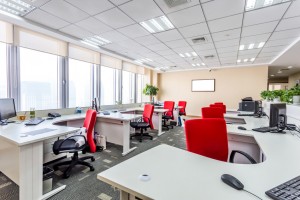Thanks to the popularity of technology hub Silicon Valley, the way business is being done is drastically changing across the entire nation.
Seemingly, whatever innovative business trend that is being tested and implemented in the Valley eventually makes its way into the U.S. mainstream. The most recent big idea that has spread across the country to both small and large corporations is the dissolving of the conventional workstation (better known as the cubicle).
Over the years, the average individual workstation has shrunk. In 1992, the average workstation for a single employee was about 80 square feet; in 2017, the average workstation is now less than 40 square feet. However, thanks to Silicon Valley’s penchant for innovation, workstation sizes are decreasing even more drastically. In fact, in many offices, the traditional work-space may disappear entirely.
Over the past several years, more and more technology companies have eliminated the cubicle in favor of open workstations. Allegedly the open workstation promotes collaboration and breaks down barriers between employees and supervisors. On top of that, some human-centered design experts say that Millennials especially hate working in cubicles.
But many companies are getting rid of workstations altogether; instead, they are allowing employees to telecommute.
There are currently 21.1 million firms in the U.S. without any employees. These are mostly people who were successful in starting a freelance business so that they can work from home or telecommute. At the same time, there are a significant amount of businesses that are closing down offices and physical job spaces, all while remaining successful and having plenty of employees on their payroll. This is possible because of technology allowing virtual workstations.
“Knowledge workers no longer work within the boundaries of a room,” said Amit Jain, CEO of Prysm. “They can work from anywhere and we have the tools to ensure this.”
According to Beta Fortune India, Jain and other high-profile techies in the U.S. are starting entire companies that focus on digital workspaces.
“We have not moved from hardware to software,” Jain added. “What we are saying is now we offer not just the hardware but a total solution.”
Though Prysm and similar companies are enjoying success with their virtual workplace model of business, it might not work from company to company or even employee to employee.
“Not everybody is cut out for working from home,” said Jack Aiello, a psychology professor at Rutgers University.
According to Newsday, an employee’s personality, the environment, and the company’s culture are the three indicators of whether or not a work from home business model will be successful.
“Two things are required to be a successful work-at-homer,” said Kit Yarrow, a consumer psychologist and professor emeritus at Golden Gate University, “the ability to be a self-directed, focused planner and a healthy dose of introversion.”
Only time will tell how successful the nation’s workforce will be as more and more organizations move toward the work from home model of business. In the meantime, the physical workstation and cubicles of the past are slowly going extinct.







